#golden age comic book heroines
Text

Tiger Girl was an Indian princess version of Sheena who appeared continuously for nearly a decade in Fight Comics, published by the heroine-friendly Fiction House, between 1944 and 1954, the year of the publishing house’s demise. Apart from the setting of a never-never “lost kingdom” in a non-specific part of Africa, there was little to distinguish Tiger Girl from her East African inspiration, other than the lethal-looking bullwhip she wielded in order to subdue her enemies and her two “pet” tigers , the aptly named Scimitar and Spear, whom she deployed to protect her “domain” from evil intruders and exploiters.
Tiger Girl’s back story was interesting in that she was the daughter of an Indian aristocrat named Rajah Vishnu and an unnamed Irish mother. This actually made her the only mixed race jungle woman of the Golden Age but inevitably, and in true Sheena homage style, she was inexplicably depicted with flowing golden tresses (although interestingly, in her earlier adventures she is shown as a redhead). Her father brought her to Africa, somehow founded a realm there, which his daughter took to patrolling in adulthood in true jungle girl fashion, complete with tiger skin bikini. Tiger Girl, like Sheena, tended to the more “savage’ aspect of the jungle heroine’s nature, frequently not taking her loathsome enemies alive to face justice, but allowing the brutal laws of the jungle to run their course. Derivative Tiger Girl may have been, but she was a popular storyline, indicated by the title’s longevity and by the fact she was Fight Comic’s cover character for much of her run.
In the page featured, a crazed scientist named Remington, attempting to take over Tiger Girl’s kingdom with an army of intelligent apes, is defeated by a combination of the jungle girl’s whip, her two tigers and a friendly local tribe. We are assured the vanquished Remington “shall pay!” but what that means is left to our imagination.
Tiger Girl was the creation of artist Robert Hayward Webb, who also worked on Sheena. The writers of her stories are unknown. The page featured is from the Tiger Girl adventure in Fight Comics #80 (May 1952).
Sources: Bleeding Cool website and comicbookplus
#women in comics#tiger girl#golden age comic book heroines#golden age of comics#fiction house#fight comics#jungle heroines#jungle adventure
7 notes
·
View notes
Text
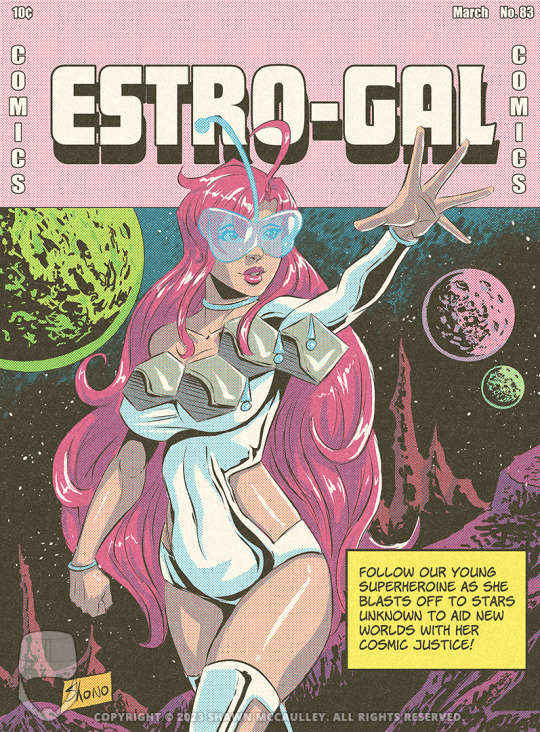
Next YCH commissions is Estro-Gal
If you'd like your character here check out my pinned post about it then send me a DM!
If you'd like to help support my comics and art consider becoming a patron. $1 a month goes a very long way in helping me make more art for you. http://patreon.com/shadowsofoblivion
#ych#ych commission#ych open#ych art#your character here#retro comics#golden age comics#comic book cover art#comic book covers#comic book art#comic book#superheroine#super heroine#amazon warrior#superhero#classic comics#ben day dots#comics#anime tiddies#anime tiddays#art commissions#anime girl#female superhero#heroine#cosmic hero#comic art#pink hair#pink anime aesthetic
0 notes
Text
Berserk's Continued Popularity and Trauma

I often keep up with what's selling in the manga world, so it's not a surprise that I check out ICv2's Manga Week when the site posts up interviews and insights about the industry. What caught my eye this time was Kentaro Miura's Berserk still being a top-seller and a top manga franchise in the English-speaking side of the world.
How popular is Berserk right now? It was the top manga franchise of Fall 2023 beating out everything that was either Shonen Jump, Junji Ito or Attack on Titan. The Deluxe Editions have sold well for all of 2023, especially the first edition (which contains Volumes 1-3 of the series). It helps that Dark Horse Comics, the North American publisher for the manga, has been promoting the Berserk Deluxe Editions non-stop. Even when they didn't announce anything new at Anime NYC last year, Dark Horse made a huge note about the latest Berserk Deluxe Edition that would come out.
I think it's great that Berserk is getting a lot more attention (especially after Kentaro Miura died) because this is a story about trauma and how we still carry the wounds of it at times.
In my opinion, Berserk is a story about people trying to overcome their own trauma - one caused by interpersonal relations. Ultimately, it's about three people in particular. Guts, the main hero who falls into despair after his experiences in the Golden Age Arc and has to deal with the curse of constantly being hunted by monsters beyond his imagination. Griffith, the antagonist who once had admirable dreams, but fully gives into darkness after going through painful torture and is the main source of Guts' trauma. And Casca, the strong heroine who becomes a victim of Griffith's desires and mentally shattered as a result until recent events in the manga. The connection between all three characters says it all - sometimes, the trauma caused is not from strangers who are "dangerous," but those closest and dearest to us.
Berserk is so relatable because we carry on the weight of whatever personal trauma we experienced without realizing its hold on us until it becomes apparent. The worse thing is we often have a very hard time talking about it.
Around 2021, I heard about a certain book about trauma that took during the COVID pandemic. It was Bessel van der Kolk's The Body Keeps the Score. Originally published in 2014, the book blew up for good reason because COVID forced everyone to confront issues kept hidden for a long time. Van der Kolk talks about how horrible people can be to one another and that psychiatry seems to ignore the complexity of trauma when it comes to helping its victims.
Because of the nuance and how long it takes to heal, maybe that's why we can't talk about trauma easily.
Which is why I want to get to this point - I sometimes find it hard to talk about Berserk because of the sexual violence and horror aspects. Yes, fans love to call it the GOAT and/or recommending the manga to other manga/Western comics fans. But I will say I can't exactly recommend Berserk to anyone who's experienced trauma, especially sexual trauma. If they haven't come to terms and/or processed their pain, why would any manga fan shove Berserk in their face? I know there's heavy debate about microagressions and triggers, but just because it's critically-acclaimed doesn't mean it's for everyone.
I will say that the sexual violence in Berserk is used in a way to highlight the brutality of the real world at times. It serves its purpose in the story. Maybe I feel that Berserk is about acknowledging the dark side of life. The world is full of absolute cruelty. And maybe more importantly, you never fully move on. That's the key point. Moments that hurt will stick by you for a long time. People love to shame others for not being able to move on and/or cheer up. They don't know how trauma forces its victims to stay still out of a realistic yet unhelpful fear of certain kinds of people.
But you can still move forward. I'm admired by Guts fighting in the face of despair. He embodies the belief that you probably can never move on from whatever emotional pain you experience and that's okay. At least take the steps to make your own life worth living. It's the best you can do for yourself.
And a good start to moving forward is accepting the bad thoughts. I recently read how positive thinking is pushed so hard to promote better mental health. Some positivity is fine, but there's so much pain in this world that all the wellness industry strategies in the world will never make go away. It is a huge problem when we're told to grit and grind while suppressing our inner-most vulnerabilities.
A lot of people can't handle that kind of vulnerability. Maybe that's why I'm happy that Berserk is being discovered by new fans. Guts is a strong yet so very vulnerable hero. I think it's those vulnerabilities due to his trauma that allow him to gain some very good friends (Puck, Farnese, Serpico, Isidro, and Schierke) along the way who genuinely care about him.
We all want someone to acknowledge our pain and be willing to sit with and stick by us through the neck of it all.
I remember a friend who once told me that when they went to see someone perform, all of their grief and vulnerability was so apparent that they wished that they didn't need to air it out since a lot of people can't handle it. I told them I can handle it and they said that I was built different.
Much like the popularity of Berserk these days and what I hope the series encourages, I want my difference of being able to sit with trauma to be the norm.
14 notes
·
View notes
Text

The Golden Age of superhero comic books cast a huge shadow on artists from all around the world and the Philippines were no exception.
Back in the 1950s Mars Revelo and Nestor Redondo gave us Darna, a crime fighting extraterrestrial who decides to inhabit the body of Narda, an orphan, who lives with her little brother, Bing, and their grandmother ...
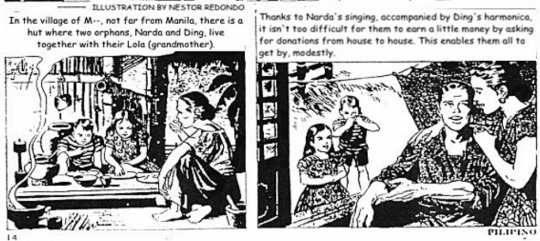
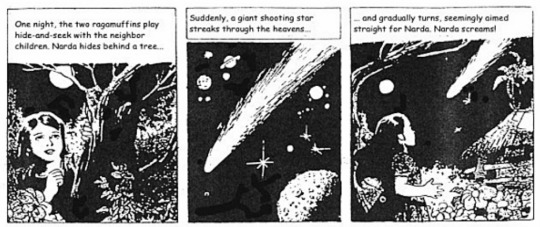
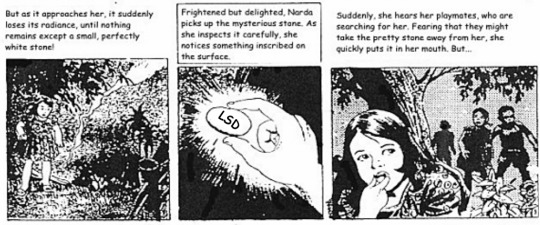
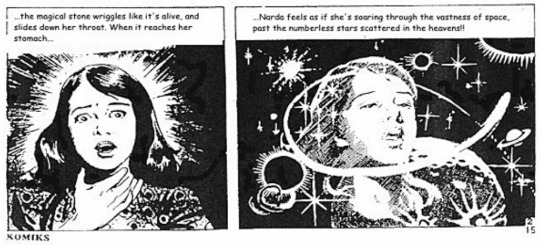
[translations by Multo Ghost]
Needless to say Bing and Grandma don't react very well the first time not Wonder Woman shows up ...
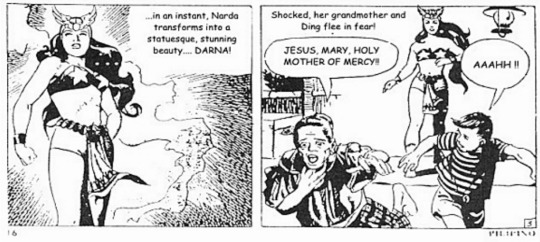
Soon, however, Darna is out fighting crime and righting wrongs, with her brother Bing as the sidekick (because child endangerment laws had yet to be invented, it seems). Her primary adversary was Valentina, who (the authors go lengths to point out) is totally not Medusa:
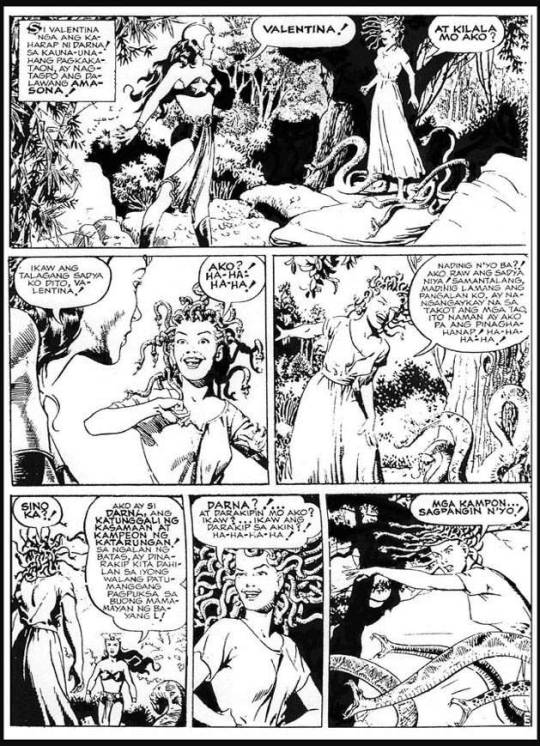
Perhaps it isn't all that surprising that as Darna kept getting popular she started appearing in her own television shows and movies (the last series coming out in 2022) ...
youtube
Darna at ang Babaing Tuod (1965) staring Gina Alonzo.
Perhaps you needed to have grown up with the source material, but as comic book heroines I'd never heard of before go, I find Darna endearing in a curious sort of way.
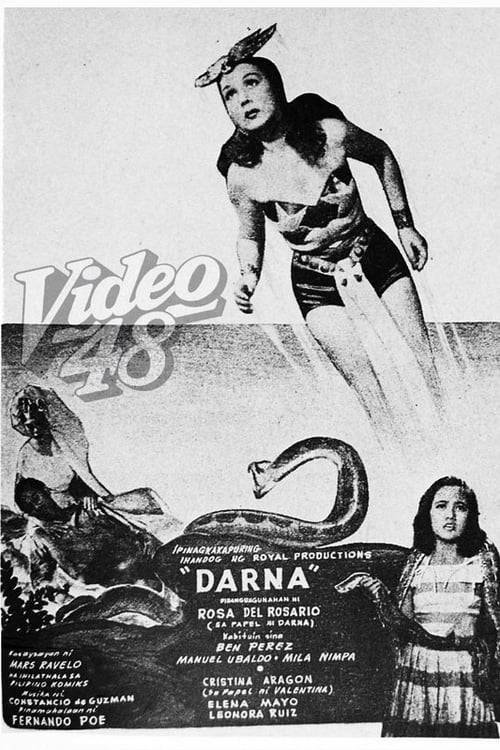
24 notes
·
View notes
Text
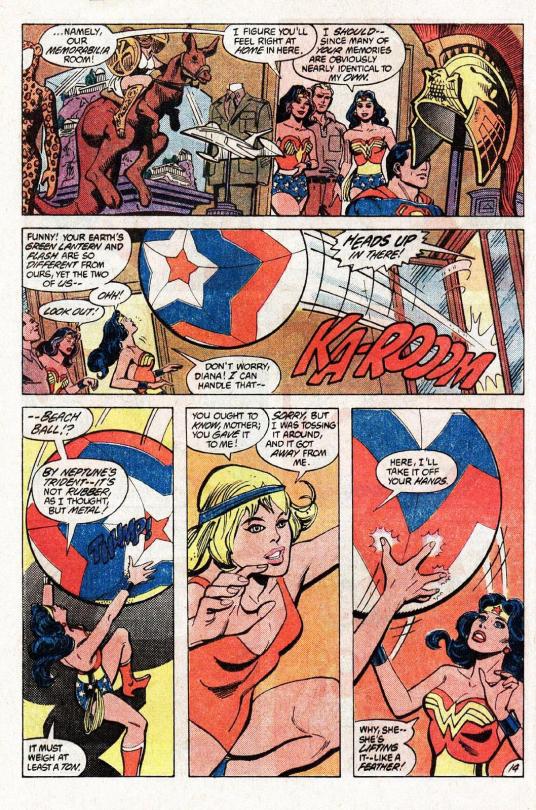
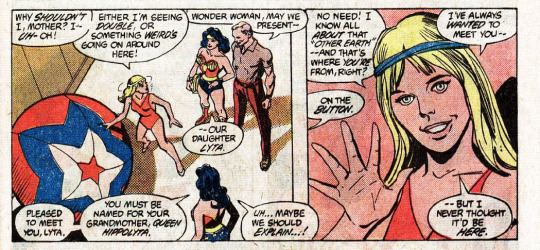
February 1983. In one chapter of WONDER WOMAN #300, the Wonder Woman of Earth-1 finds herself on Earth-2, where she learns that her older Golden Age counterpart married her world's Steve Trevor in 1963 — and meets their teenage daughter, Hippolyta (Lyta) Trevor. Unlike the Earth-2 Batman and Superman, there was never any story describing how the Golden Age Diana and Steve finally came to marry, beyond their brief explanation to the Earth-1 Diana in this chapter. Their daughter Lyta subsequently fell in love with Hector Hall, son of the Golden Age Hawkman and Hawkgirl, and the two became founding members of Infinity, Inc. as Fury and Silver Scarab.
The Crisis on Infinite Earths banished the Earth-2 Wonder Woman and her husband, who were taken off to Olympus to dwell among the gods, but Lyta remained. This unfortunately required her to receive a heavily revised origin that made her the daughter of Helena Kosmatos, the newly invented Golden Age Fury, later raised by Joan Dale Trevor (an obscure Quality Comics heroine called Miss America) and her husband Derek Trevor, a retired admiral. It could have been worse — as Neil Gaiman soon demonstrated in SANDMAN, where Lyta was subjected to relentless abuse that also apparently made her off-limits for non-Vertigo DC books until around 2006. (I certainly hope Roy Thomas got some media royalty checks for the recent use of the character in the awful SANDMAN TV show, although if anything it's even worse than the comic in its treatment of her.) All very grim, and in retrospect, it might have been kinder to just kill Lyta off like Helena Wayne.
#comics#wonder woman#roy thomas#ross andru#dick giordano#earth-2#diana prince#steve trevor#lyta trevor#fury#hector hall#crisis on infinite earths
23 notes
·
View notes
Text
Lyta Hall

Lyta is one of the most changed characters between the comics and the Sandman adaptation, so much of this will have limited applicability to her show version, I imagine. One of the interesting things I discovered in reading all of her pre-Sandman appearances was that the show version is in personality more like the character as she had previously appeared in comics than the Sandman comics version is. The difference is profound enough that it makes me wonder if people who had liked Lyta at the time were kind of upset with what the Sandman comic did with her. I didn’t think I’d be saying this — I love the Sandman comic dearly and it’s very important to me — but Neil Gaiman did her dirty back then. She was a minor character from a canceled series who had been written off even before it was canceled. She had too much bad writing making her all about her boyfriend, she was creepily mindwiped of the memories of her real parents, her backstory is a mess. She was still done dirty. I’m glad the show seems to be giving her back some of the agency and self-confidence that she displayed in Infinity, Inc.
I should, at this point, warn that Lyta’s backstory is a mess deeply rooted in some of the weirder, more complicated parts of DC comics history. Her story starts out on Earth-Two. Earth-Two was a development based in a problem of DC history, a problem Marvel mostly never had, which was the difficulty of reconciling WWII canon for their flagship characters. This was all well and good through the 50s, by the 1960s this was starting to strain credibility even in an era where most comics were episodic. Many of these characters, including DC’s most popular, had been operating continuously for over 20 years and plenty of them were mortal. And DC was understandably proud of its Golden Age work and didn’t want to just cast it out of continuity. All kinds of comic book tricks came into play, slowed aging, magic, all sorts of stuff. But eventually, in the early 1960s, they tried something completely different. They lopped the Golden Age comics off, plopped them in their own universe, and declared that the main lines took place in a world where the age of heroes had begun after World War Two. The Golden Age Superman, Batman, and Wonder Woman were separate characters (this also let them dump some of the sillier stuff, like the Amazons riding giant kangaroos). Also consigned to this alternate reality were the members of the Justice Society (not league) and the All-Star Squadron. Earth-Two had a lot of the Golden Age heroes who had slipped into obscurity as they were replaced by more familiar faces.
There will be spoilers for Sandman under the cut.
This is all important because Lyta was born on Earth-Two. She first appears as a teenager in a comic where Wonder Woman (Earth-One) accidentally travels to Earth-Two and meets her counterpart there. Who is married to Steve Trevor and the mother of a teen girl they are raising as an Amazon. Because of her Amazon heritage, she’s stronger, faster, and more durable than a normal human.

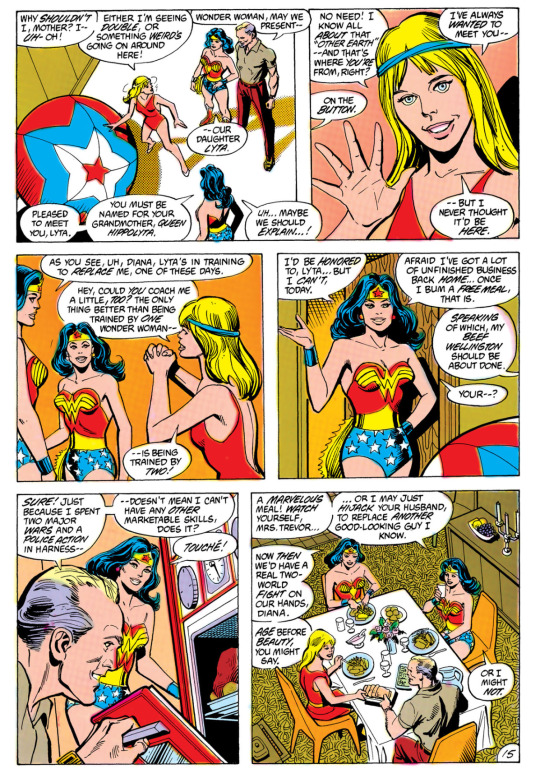
(Wonder Woman #300, Feb 1983)
As you can see, one of the cool things about Earth-Two was that the major heroes there, freed from having to carry titles that existed in an eternal status quo, had been allowed to age and change. (Batman had married Catwoman, raised a daughter, and they had both died, leaving Robin (Dick Grayson, there were no later Robins on Earth-Two and he never became Nightwing) to carry on their legacy with her. She’d become Huntress; the original version. Imagine, a long-running comics continuity where Batman could die and the death stuck!) In fact, the entire Justice Society was starting to get on in years, which is where Lyta comes in.
Lyta was, in comics terms, still a fairly new character when Gaiman picked her up for Sandman; she’d only been introduced about seven years ago (her first appearance is Feb 1983, and she shows up in Sandman in Dec 1989) and had only been a heroine in her own right since March 1984, with the first issue of Infinity, Inc. (She’d also been dormant as a character between mid-1988 and late 1989, so she actually only had about 4.5 years of publication history, compared to the Justice Society characters who at this point had 40-50 years of back issues.) Infinity, Inc was a book and superteam of legacy heroes, characters with a close connection to the Justice society, either as children or as protegees, and Lyta Trevor and Hector Hall were two of the founding members. (For those who have watched Black Adam, Atom Smasher was another, under the alias of Nuklon. Having just read all his Infinity, Inc appearances, it was nice to see Al, but I wish he’d gotten to keep his doofy mohawk.) Infinity, Inc was basically the Earth-Two Teen Titans, but consisted entirely of new characters instead of consisting almost entirely of teen sidekicks with multiple years of appearances.
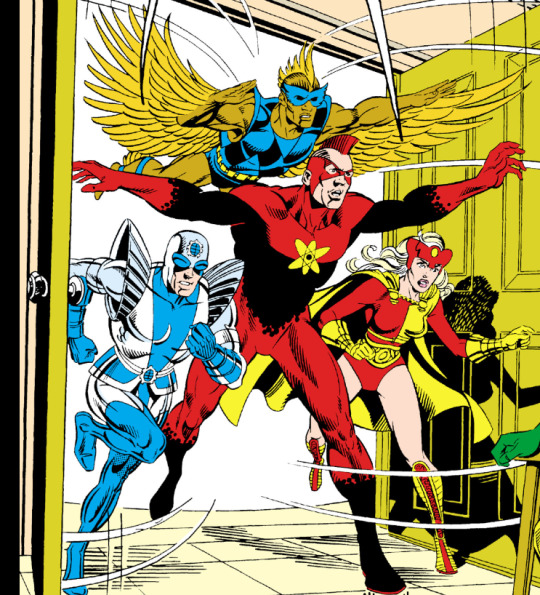
That’s her first appearance in costume, on the right. At this point, she’s Fury because she’s pulling from the Greek pantheon that’s her Amazon birthright. She’s assumed her own identity, she’s not a junior version of her mother, she has a generally very strong relationship with her parents, and a happy relationship with her boyfriend. That’s Hector Hall there on the far left, by the way. They’re already dating at the beginning of the series. Hector’s backstory is much less messed up than Lyta’s, except insofar as DC’s Hawks have a notoriously tangled continuity. But suffice it to say that Hector’s parents are the reincarnations of an Ancient Egyptian pharaoh and his queen, who were murdered by an enemy, and they are also the superheroes Hawkman and Hawkgirl (not the alien ones, those are different), who fly with the help of wings made out of a substance called Nth Metal that they discovered in the tomb of their original pharaonic selves. Hector’s suit is made out of the same stuff, and he feels like his parents were so obsessed with superheroics and figuring out the secrets of their past lives through archaeological digs that they never gave him enough attention. I wouldn’t bother you with this but it becomes relevant later on.

The beginning of Lyta and Hector’s romance.
So they go off, form their own team, do a bunch of superheroics, some more successful than others, and generally act like perfectly ordinary superheroes. Most notable through here is that Hector and Lyta sometimes have values conflicts and she is completely comfortable holding her own. Being raised by Wonder Woman and spending her summers on Paradise Island means she’s grown up extremely confident in her abilities and beliefs. This is where I feel like Gaiman sold her short, although there are some mitigating factors to that decision.
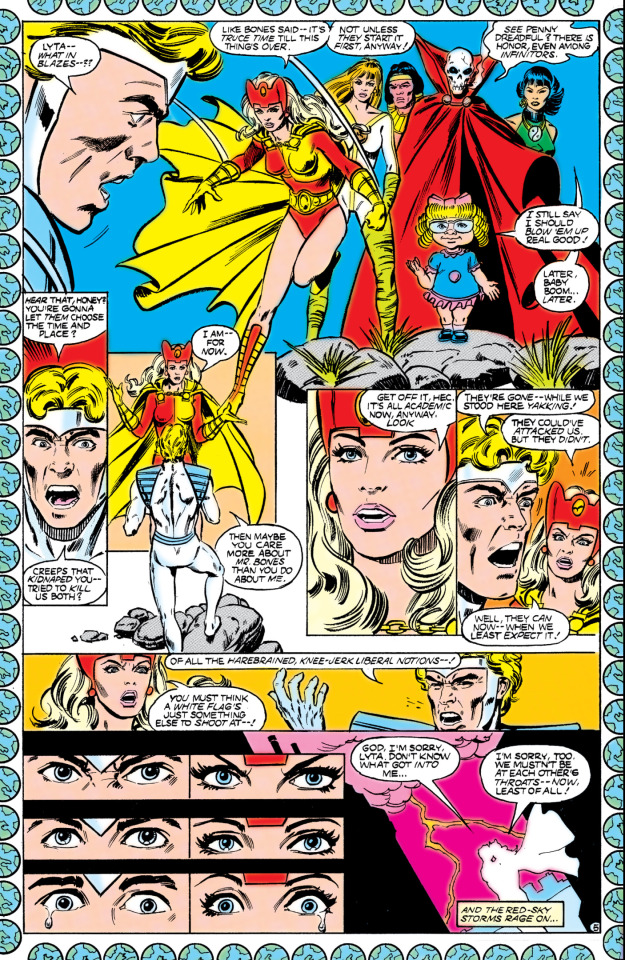
That kind of reaction is very natural for an Amazon, but it would be very foreign to the Lyta Hall of Sandman. While I imagine that was part of the point, there’s also the question of how she and Hector got to a point where that would seem like a reasonable direction to take the character. The answer to which begins shortly after this issue, in the aftermath of the Crisis on Infinite Earths.
Crisis collapsed the entire DC multiverse (most importantly Earths One, Two, and Four (the Earth where the Charleston Comics characters like Blue Beetle lived)) into a single reality called New Earth. Most unique characters just kept right on going, some of the ones with duplicates died or were erased from existence or chose to travel beyond the boundary of the multiverse because there was no longer a place for them. The Earth-Two characters mostly remembered having been from an alternate universe for a while, but the JSA and their now-messy backstory was conveniently shuffled off stage by trapping them eternally in fighting Ragnarok (they’re still there during Sandman, there’s a brief mention in Season of Mists.) This means that Hector Hall, whose parents did not have an Earth-One counterpart (the Earth-One Hawks were aliens), retains his backstory and history. Lyta, the daughter of a now-redundant Wonder Woman, was not so lucky.
The weird thing there, part of a series of what I found to be genrally odd, often upsetting choices, is that Lyta’s backstory wasn’t just rewritten with the formation of the New Earth. Her parents survived the transition and then were taken away to Olympus, never to return.
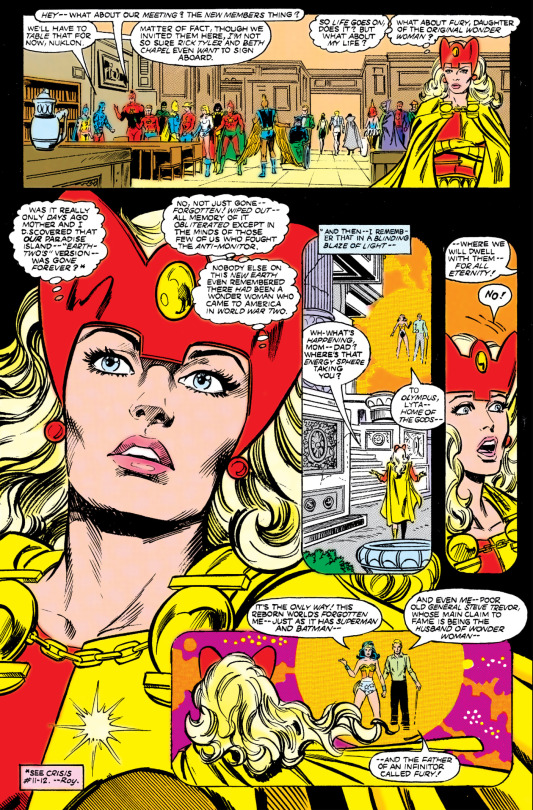
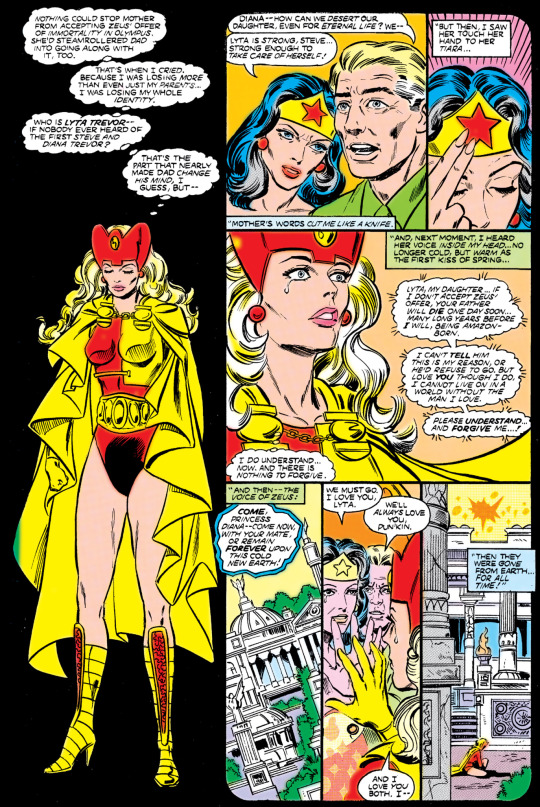
Why would anyone think this was a good way to handle this?
So anyway, Lyta is terribly upset about being in this world where she can never see her parents again and no one but her teammates even remembers they existed. Plus she’s having an identity crisis. Fury was basically a temporary identity until she someday took over from her mother, and now there’s that other Wonder Woman instead and who the heck is she? So she’s sad about that some of the time for the following issue and then in the one after that, we get this:
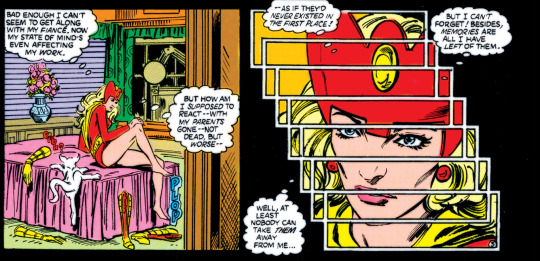
Guess what’s about to happen.
Most of the issue is Lyta dreaming/remembering a time when she met the other JSA kids as preteens (there’s eventually a second version of that seen after her backstory change, but it’s not really relevant to anything here), and then this happens. I cannot believe editorial thought this was a good way to handle their Lyta problem, I really cannot:
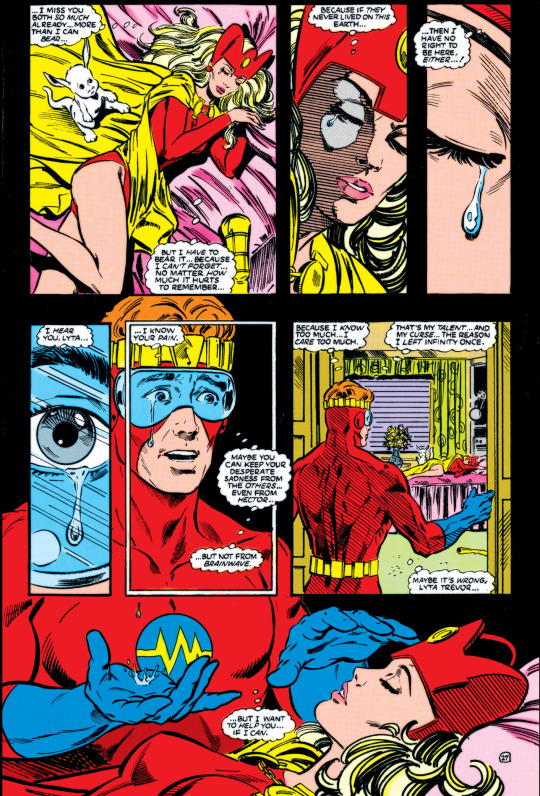
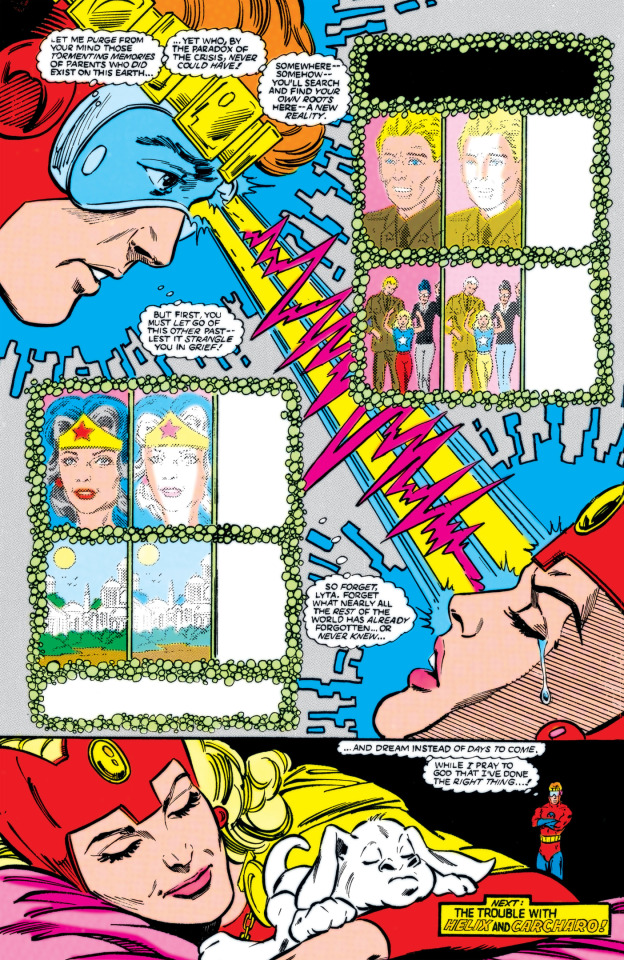
Yeah, that’s one of her teammates and ostensibly a hero. The mindwipe works so well that no one else remembers Lyta’s parents either! So after this you get this weird period where they’ve wiped Lyta’s backstory and failed to establish a new one for her and no one has any idea about her background or where the hell her pet kanga came from (Earth-Two was the one where the Amazons rode giant kangaroos, and Trouble there was a present from her mom, the child of Lyta’s favorite mount when she visited Paradise Island.) Some of Lyta’s weird fuzziness about her own motivations for being a superhero and everything in Sandman definitely come from what a complete clusterfuck her backstory had been in the last three and a half years.
At the same time Lyta and Hector start having relationship problems and he eventually breaks up with her and leaves the team. He’s a real dick in this period, but it’s pretty clear from the start that there’s comics bullshit happening and it’s not just him being a giant douchebag.
Still, before any of that gets resolved, and before Lyta’s backstory has stabilized in its new form, she finds out she’s pregnant. Yes, this is Daniel. This is also the November 1986 issue, meaning Lyta will be pregnant for more than three years of real time. No wonder she’s so vague about the length of her pregnancy in Sandman!
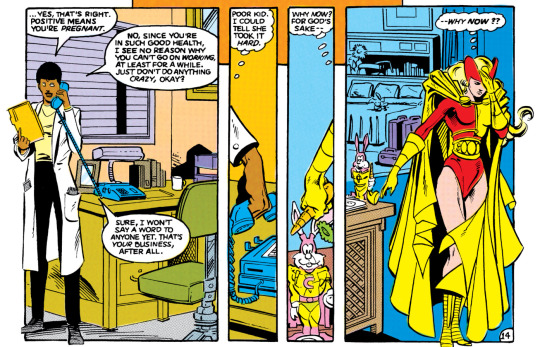
Lyta gets her new backstory in the next issue, when she starts referring to “Mom and Dad Trevor” without any explanation. There’s an editorial note to see the issue’s letter page, but I don’t have access to that. She now spent her summers on “Trevor Island,” which had giant riding kangaroos and suchlike, but was a desert island her father discovered when he crash-landed on it. Her new mom used to be Miss America during WWII, but had since lost her powers. Lyta’s also adopted and knows nothing about her birth parents, or why she has all the same superpowers that used to be explained by her Amazon heritage. Until, shortly afterward, she gets dragged to Greece for reasons and learns that her birth mother was a Greek teenager who her adoptive parents saved during WWII, and who made a bargain with the Furies that granted her superpowers. Her hero name was also Fury. (Yeah, this character was made up to cover the plot holes left by not having Wonder Woman in the WWII All-Star Squadron stories anymore.)


Turns out her mom made a bargain specifically with the Fury Tisiphone, who punishes crimes of kinship, and Lyta has inherited the powersf from her. Not that that’s particularly relevant to the climax of Sandman and Lyta’s role in it or anything.
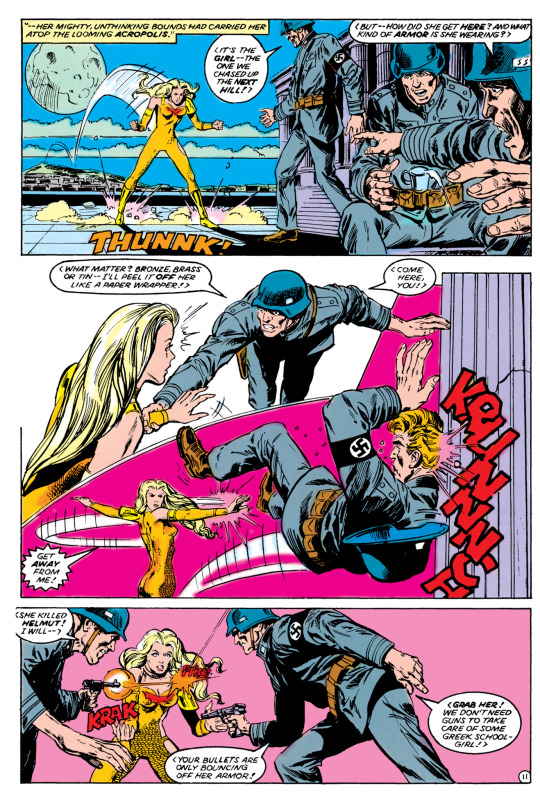
Here’s her new bio mom on her first outing fighting some Nazis.
So Lyta gets involuntarily put on maternity leave from superheroing (she’s none too pleased about this) and decides to go visit Hector at his parents’ house in New York to find out what the fuck he was doing dumping her like that, and maybe tell him about the baby if he has a good answer, and finds out that the Hawk bullshit has caught up with him. There’s an entity calling itself the Silver Scarab that insists Hector is dead.
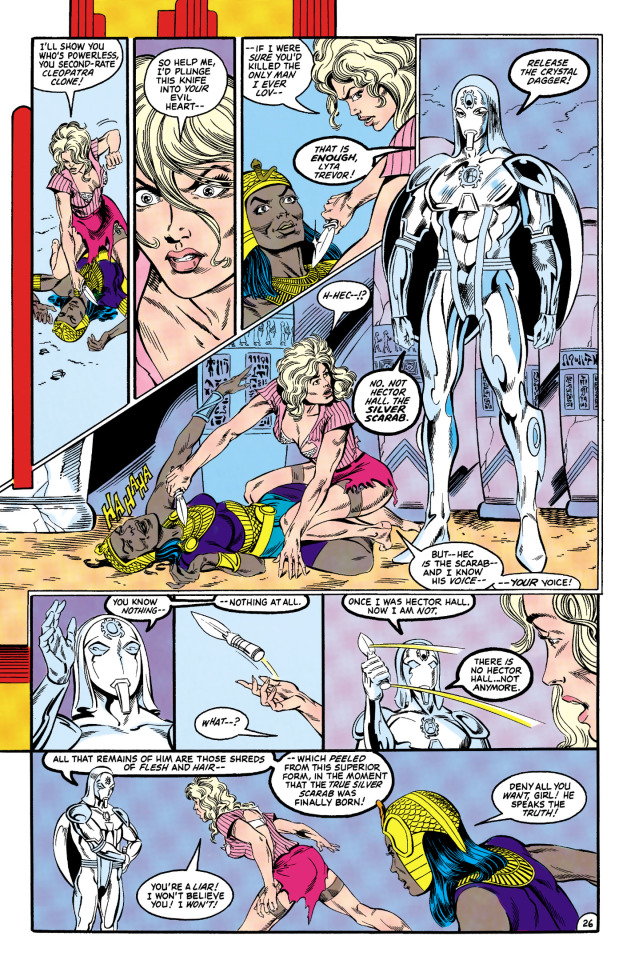
Lyta’s immediately fighting for her life, damsel-in-distress rescued by the rest of Infinity, Inc, and then fighting to save the world. They stop the Silver Scarab because Daniel’s existence means it failed to fully destroy Hector’s humanity (no, really), but Hector is dead for real and Lyta goes off to mourn with her parents. The reasoning underlying all this is pure Hawk bullshit I don’t even pretend to follow — their history is infamously convoluted so I’m not going to waste the effort untangling it when it’s really not important for Sandman.

So Lyta goes back to her parents’ home for a while and then Al flies out to ask Lyta to marry him so the baby won’t grow up without a father, which Lyta shoots down. But her dad is concerned because there’s been a prowler lurking around peeping in Lyta’s window. And that night Al hears a noise and..

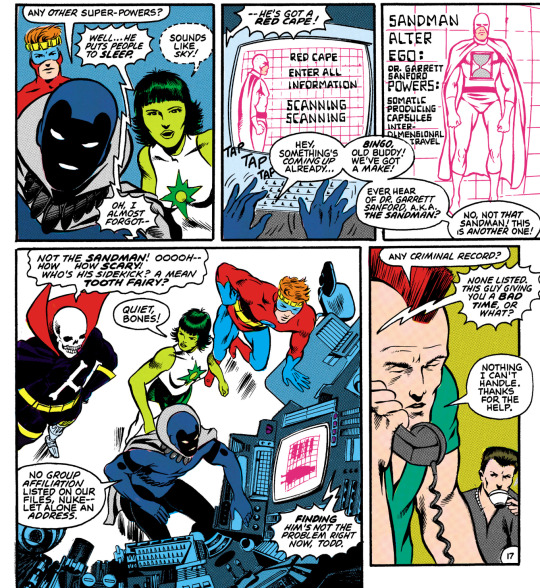
The team identifies him as Garret Sanford, the Jack Kirby Sandman from the 1970s. That’s the series that introduced Jed Walker, Brute, Glob, and the Dream Dome. Also the red and yellow Sandman costume (the “other one” is Wesley Dodds, the original Sandman and a member of the Justice Society, who in Sandman is inspired by Dream’s imprisonment and, per Odin, carries a bit of Dream’s essence.)
Meanwhile, back at the ranch,
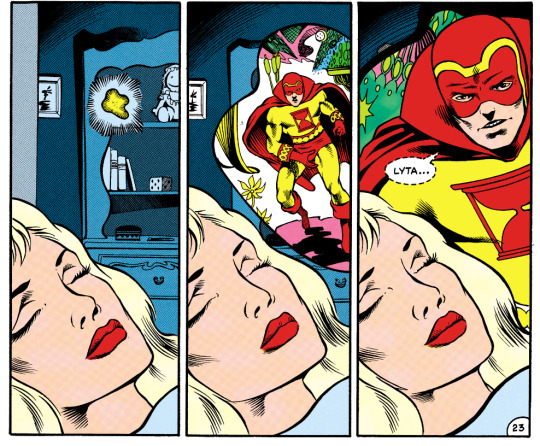


welcome back, Hector! Here’s Hector’s story in full, because it’s definitely relevant to what Gaiman later did with him in Sandman. Honestly, Gaiman’s pretty hard on Hector too, he’s a dumbass and ways too conservative for his own good, but prior to whatever creepy personality degradation happened over time to get him where he was in Sandman, he wasn’t a buffoon.
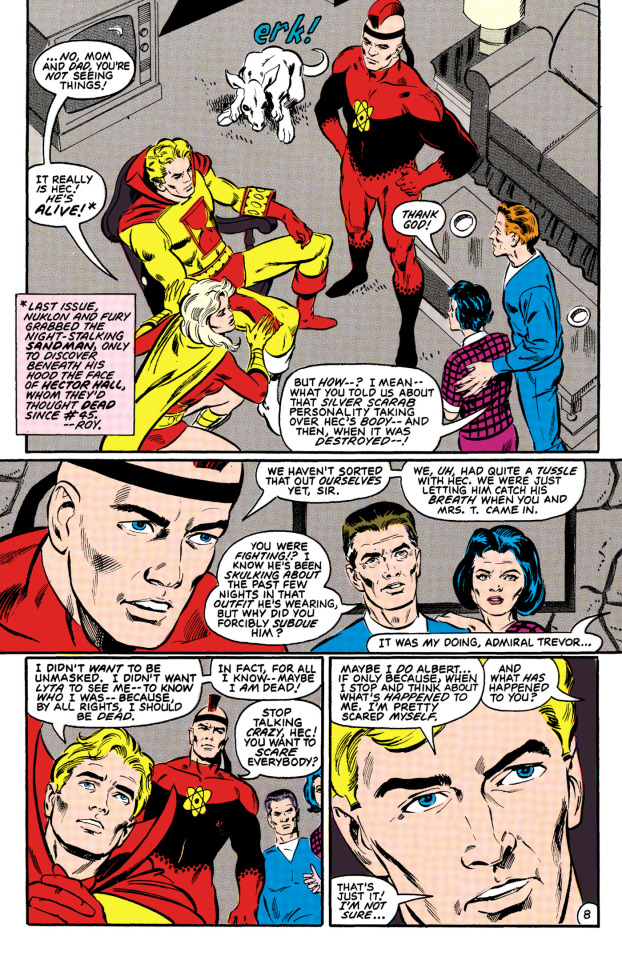




Hector and Al go off and help the rest of Infinity, Inc in a fight, but convince Lyta to stay for the sake of the baby. Then Hector heads back with about one minute of his hour a day in reality to spare and

So, the last we see of Hector and Lyta before Sandman is their wedding.

Lyta’s wedding dress is amazingly hideous.
As for why they’re so… different… in Sandman, Gaiman’s clearly playing with the mess of Lyta’s history and the way the changes removed any real reason for her to want to be a superhero, and was also commenting on the way Infinity, Inc wound up making every story about her about Hector and their relationship. At the same time, I wish he hadn’t made her such a brittle, shattered person through the rest of the series. However, just as Hector can’t leave the “Dream Stream” for very long, I know I encountered a warning in one of the comics I read (I cannot remember which one, but it was something published before Sandman) that ordinary humans also can’t remain inside for long. So I assume that some of what we see in Sandman is the inevitable effect on mortals of living so long in dreams. (It’s possible that Dream can shield people from the effect, but it’s also possible that he can’t or just doesn’t notice what it does to them because he’s so used to dreamers.)
42 notes
·
View notes
Photo

Jungle Comics #33 (September, 1942). Cover by Dan Zolnerowich.
Kaänga - Jungle Lord is just one a what seemed like a gajillion Tarzan imitators populating pulps, comics, and film back in the Golden Age. Considering Tarzan’s popularity at the time that’s understandable.
This issue also features a Fantomah story. Regrettably, it is not the “grotesque and goofy, horrific and hilarious” Fantomah created by comics madman Fletcher Hanks, and who is arguably the first super heroine in comic books. Instead, this is a reimagining of Fantomah as an Egyptian princess who protects the jungle. Pretty generic stuff, especially given the fever-dream quality of Hanks’ stories.
17 notes
·
View notes
Note
Hey Alissa, I haven't forgotten the DC magic side rec list, but I was wondering if you had any recs for other writers who write comics for mature audiences like Tom King or other specific mature works? I do love my older comic books, but I need to diversify with more 'adult' stuff, haha <3
hi!!!!! yes, absolutely! i think a lot of the dc magic side stuff does deal in mature themes and i stand by those recs, and i also think you'd really like tom king's supergirl: woman of tomorrow eight-issue miniseries (which feels to me like a narrative you might enjoy as a mary fan and that it runs parallel to a lot of girlhood/womanhood coming-of-age narratives heroines never get written so well, all under the pretext of a revenge quest across the galaxy) buuuut i will also offer this random assortment of some of my favourite black label-esque books. warning: here be every conceivable genre
first of all, as a fellow lover of the golden age of comics, i'd recommend james robinson's work with my whole entire heart. i believe he's the one writer at dc palpably influenced by the golden age and obviously in love with it, nobody deals in nostalgia as well as robinson does and certainly nobody appreciates the characters of back then the way he does. there's starman 1994, of course, but that's an 80-issue commitment so i'd start you off with the vigilante: city lights, prairie justice 1995 four-issue miniseries and the golden age 1993 four-issue miniseries (both of which are two of my all time favourite books generally)!
one of the earliest comics creators to deal in mature themes is also howard chaykin, whose work i've been slowly making my way through, and i've really enjoyed his blackhawk 1988, the shadow 1987 and twilight 1990 miniseries. they are, admittedly, a little bit hard to get into at first (he's primarily an artist and the narrative in all is very obviously focused on the visual, dialogue as an addendum to what's happening in any given panel) but i liked all three extraordinarily much, particularly as part of my quest to read as many kinds of comics as i can and really see what the medium's got to offer.
i'm not one for bats, as we all know, but one modern mature book i did enjoy is arkham city: order of the world -- the six-issue miniseries that ended a few months ago and follows a bunch of escaped arkham patients (of the very obscure variety) and the doctor trying to hide them from the cops, it all veers into very occult territory (arkham as a sentient part of the city and such) but it's beautifully drawn and i think one of the very few modern books to manage 90s vertigo-style surrealism.
and speaking of modern stuff, there's always ram v and his astounding work -- i'd especially recommend the many deaths of laila starr from boom studios, which is steeped in magical realism and follows the embodiment of death being fired from her job & living in mumbai, and the swamp thing from dc (no context needed from any previous swampy books, it's standalone!).
otherwise, there's always various elseworlds miniseries like jsa: the liberty file 2000 and jsa: the unholy three 2003, each a two-issue mini set in a noir-tinted world of wwii espionage. or, if you have any interest in war stories at all, there's enemy ace: war idyll and its exploration of the stark contrasts between wwi & the vietnam war and its gorgeous gorgeous art.
there's a lot and i haven't even gotten into humour books yet (like all of keith giffen's repertoire but particularly ambush bug titles!) or some of the usual suspects (watchmen is worth the hype, it's extraordinary!) BUT i hope you find something you like in here and if not, feel free to give me more specifics and i'll try to think of something! enjoy!!!! <3
9 notes
·
View notes
Text
arca | books ’22
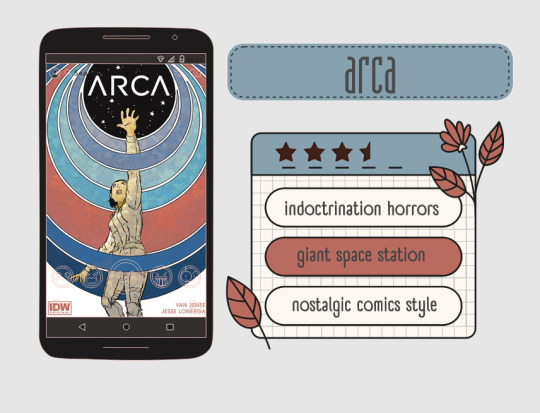
book: arca by van jensen
rating: ★★★.5
genre: science fiction | graphic novel
An intriguing premise within a well familiar genre - you can guess the general direction from the get-go but the particulars are picked up alongside the main heroine. In some ways, I felt like the mystery was kept on for too long and left the ending rushed, and I have a hard time recalling how everything unravelled exactly. There were certain aspects I felt were left unanswered, especially regarding the reveal at the very end.
I am not well versed in the particulars of artwork, but the style of Arca reminded me of a particular era of comic books, like the golden age, maybe, the 30s or the 50s. It added to the atmosphere of the writing, and put down some totalitarian feelings I cannot articulate more eloquently. A particular nod I will give to careful analogies, I felt like the dots of referencing throughout hit just the right balance. It is not heavy-handed, nor repetitive, when characters recall and compare their condition to literary pieces and more. The stakes of graduation was the right kind of eerie to keep me engaged, and I liked how brainwashing echoes in how characters’ language worked around it.
I have received ARC in exchange for an honest review, courtesy of Netgalley and IDW. Thank you!
#bookblr#arca#book blog#book recommendations#book reviews#booklover#graphic novel#graphic novel recommendation#space#idw
2 notes
·
View notes
Text
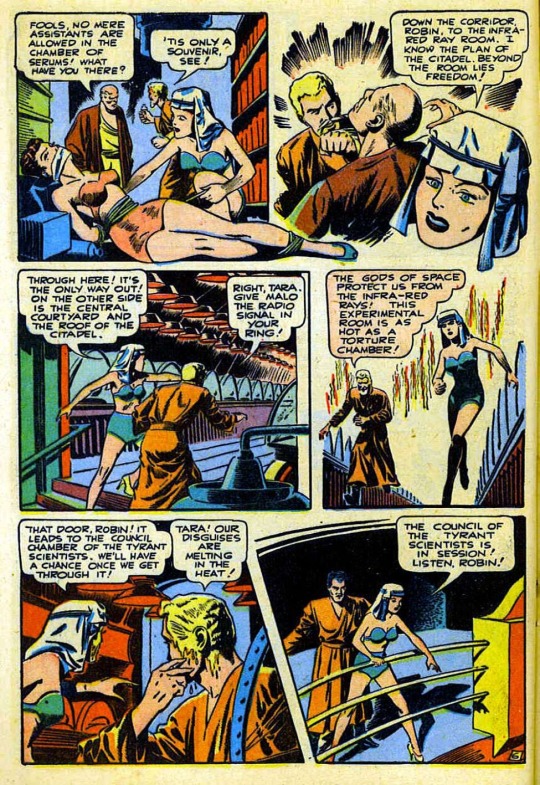
Tara, Outlaw of the Universe, was unusual for a Golden Age heroine in that she led an outlaw gang of men, Robin Hood-style, in an effort to save earth from any number of monsters, pirates and aliens looking to destroy it. Tara’s outlaw status, together with that of her sidekicks, Robin and Malo, occurred when they were forced to provoke war between Earth and Mars when the Martian ambassador freed the evil pirate Atto, whom Tara had captured and had brought back to earth to face justice. Although her adventures were action-packed, Tara enjoyed a run of just six comics, the last five issues of Wonder Comics and her final jaunt in a single story in Thrilling Comics. Basically Tara and her friends were an interplanetary version of Pirates of the Caribbean, but despite the silliness, the stories are great fun, and Tara herself a resourceful leader of men.
In the page featured a disguised Tara and Robin are on Mars, hunting for a serum to cure a deadly virus unleashed on Earth by a dancer named Leela who turns out to be a Martian spy. They really should have made an RKO TV series out of Tara’s adventures.
This page is from the Tara story The Death That Grew, published in Wonder Comics #20 (October 1948). Art was by Gene Fawcette.
Source: Darkworlds Quarterly website, March 2020 and comicbookplus
#women in comics#strong woman#wonder comics#Tara pirate of the universe#golden age comic book heroines#golden age of comics#space adventures
6 notes
·
View notes
Text
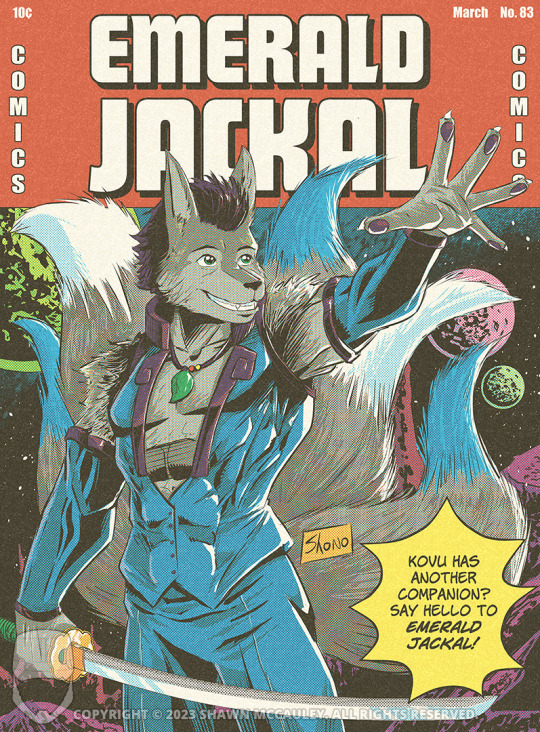
Next YCH commissions is Emerald Jackal
If you'd like your character here check out my pinned post about it then send me a DM!
If you'd like to help support my comics and art consider becoming a patron. $1 a month goes a very long way in helping me make more art for you. http://patreon.com/shadowsofoblivion
#ych#ych commission#ych open#ych art#your character here#retro comics#golden age comics#comic book cover art#comic book covers#comic book art#comic book#superheroine#super heroine#superhero#classic comics#ben day dots#comics#art commissions#cosmic hero#comic art#fursona#furry oc#anthro art#furry art#5 tails#katana
1 note
·
View note
Text
iFeature | DC’s STARGIRL Re-Enters a Golden Age!
iFeature | DC’s STARGIRL Re-Enters a Golden Age!
The CW hit series returns for Season 3 and proves it has the goods to stay in the game reigniting the DC Comics “Golden Age” of heroes in primetime, while a new series of books prepares to hit newsstands!
She’s a star! Going into its Third Season on The CW Brec Bassinger continues to shine as the titular heroine in the superhero adventure series DC’s Stargirl which made its fall debut this week.…

View On WordPress
0 notes
Text
The black widow story and also information - ideas to let you understand extra
Black Widow is a fantasy superhero appearing at comic books in America, which is released by the Wonder Comic books. An anti-heroine is ruined the ruffians to bring their spirits to Satan and her master. Originally, her main arises in the Mystic Comics, which are published by the Wonder workshops. It was in fact developed by the renowned writer George Kapitan and artist Harry Sahle. The Black Widow is likewise unconnected to the Wonder's later superspy character.
A comprehensive evaluation concerning Wonder's Black Widow personality
Physical appearance
Really, the black widow produces 5 looks throughout the followers period and also the chroniclers call a Golden age of the comics, which all these five composed by the George Kapitan. Throughout a bulk of the twelve, she clothing a fifth one as well as additionally a small redesign consists of a dark purple bodysuit with in a lighter shade of purple. She totally covers the whole body other than hands and heads along with functions a crawler internet pattern through much of its surface. Still both the fires and also boots are yellow and thus black widow is a redhead.
Motion pictures
The black widow is acted in many movies such as Iron Guy 2, the Soldier as well as Avengers: Endgame, the Avengers, Avengers: Age of Ultron, Avengers: Endgame, Captain America: the winter season, Avengers: Age of Ultron, Captain America: Civil War, Avengers: Endgame and Avengers: Infinity War.
Personality
A consistent character function of the black widow in her golden era looks is that she shows no unpredictability or empathy, when it concerns killing her deaths and also no noticeable remorse over denying them of their lives as well as also sending their souls to agony for continuous agony. Whether this ruthless feature of her individuality is initial to Claire Voyant or a subsequent of her resurgence by Satan as a black widow doubts. In golden era seems, she does possess great issue for those she categorizes as blameless deaths of bad and likewise a willingness to use her strengths to guard and likewise recover them.
Modern personification
In the twelve, the Claire Voyant is retconned as ending up being a black widow in the year of 1928, after her sister is eliminated. By dominating her sis's memorable, she desires for stamina to retaliate herself versus an awesome as well as the Satan responds. Rejuvenated in this existing day along with 11 other heroes after remaining in suspended animation given that Second World War, she recommences give outs as a device of retribution for an originally unidentified creature and likewise going on the objectives for that event.
Powers as well as capacities
Before her modification right into a black widow, the Clair Voyant has undisclosed the spiritual toughness enabling her to talk with the sensations of a departed. Renew by Satan after her murder, the black widow has been approved the mythological powers as well as enabling her to return the significances of bad people for her master. She also has a death touch power. When green arrow cosplay costumes among her sufferers on a temple, there is a rupture of fire as well as also they are instantly struck dead in addition to their spirit is sent to heck.
In her modern-day search in the twelve, she exposes an ability to fly and also the superhuman toughness enough to divide the human bodies to items. In fact, she still owns her death touch power as well as additionally only time she is revealed attempting its usage and also it not passes to work with a non-human object. The Satan claims that he has finished her continuous. Within a context of the 12, the Claire Voyant becomes black widow in the year of 1928.
Costume
During her 5 short looks in a golden age, the black widow attire 4 unique costumes with various shade strategies, different styles as well as additionally has 3 distinct hair shades. It is also looking in the mystic comics and also her first costume includes a purple bodysuit with a spider design on the belly, red boots with yellow flame designs as well as additionally a green and blue striped cape around the tops. For her second look in mystic comic, the red boots with yellow fire cool stay alive and still a bodysuit comes to be the basic rear without any spider layout as well as likewise a color of her mantle changes to the solid red.
0 notes
Text
https://forward.com/news/465805/this-jewish-female-artist-from-the-comic-book-golden-age-was-overlooked/
16 notes
·
View notes
Text
The Hotness of Hypnotized Hero(in)es

Photo by Mahdiar Mahmoodi on Unsplash
Time for another essay question, sponsored by Dedicated Procrastinator’s generosity with coffee. He asks:
What is it about the hypnotized hero(ine) genre you love so much?
There’s a lot of things, obviously. One doesn’t write a dozen e-books and hundreds of flash fiction pieces in a genre without a lot of fuel in the tank. Some inspiring aspects of my chosen sub-sub-subgenre:
Familiarity: I’ve mentioned reading a lot of comics over the years. I’ve never counted but I’m sure I’ve read thousands of issues, certainly. Add to that the fact that we’re living in a golden age for superhero media. So I can watch high-quality, well-written superhero TV shows and movies and animated off-shoots whenever I want. They say “write what you know” and I know superheroes (which is not to say I know everything about all superheroes, there’s just too, too much).
Sweeping Breadth: As a genre, “superhero” stretches to accommodate virtually any and every other genre. Every sort of non-realistic, flamboyant extravagance is on display. Ultra-advanced technology that breaks the laws of physics. Magic learned from musty, ancient tomes. Aliens with powers unimaginable. Hard-boiled vigilantes with hearts of gold. Monsters lurking in every shadow. Gods of myth and legend. Robots yearning to understand their creator. None of it is out of place in a superhero story. Whatever weirdness my muse can come up with will fit just fine.
Optimism: Corny, I know. But I like that all my superhero stories end with the heroine winning in the end. It gives me a little hope and puts a smile on my face. Plus, there’s a creative challenge that’s fun in every story I publish: I get to put the heroine in a worse and worse situation, and then figure a way for her to get back out again! Sometimes it’s really tricky, but a hell of a lot of fun!
Insulation from Reality: This one is hard to find the right words for, but I’ll try.
Power: Superhero stories are about power. Who has it? What do you do with it? What do you do without it? What does it do to you?
Sex is a real thing that happens with real people in the real world. Genuine, living human beings delight in, and get hurt from, sexual issues every single day. Sex is important. The way we talk about sex is important. The way we think about sex, our own and others, is important.
But making things important is a guaranteed way to get my muse to pack her bags and head for parts unknown. I write for a lot of reasons but the most important one is stress relief. The pressure to address an important issue in an appropriate and responsible manner compounds my stress, rather than relieving it.
So, I write stuff with lewd lasers, erotic explosions, horny hypnosis, ribald robots, and spells of sexual sorcery. Writing the wacky superhero stuff allows me to let myself off the hook of always addressing important topics with appropriate gravity.
That said, I try to address the emotional reality of my characters as best I can. That’s where real erotic thrills come from, I think. Only you, as my readers, can judge how well I do that.
Folks in kink communities talk about “power exchange” of the dominant/submissive relationship. Who has power over your actions? Is the sort of question that comes up in hypno/MC-themed erotica all the time. There’s a lot of subtlety and nuance to be explored in the lines between consent and coercion, of giving into persuasion and being freed from one’s inhibitions. Those can powerful stories.
But they are not the type of stories I write. My brush is too broad for such fine-grained psychological realism (all those comic books, surely). My muse provides me with a big special effects budget and expects me to spend every dime. Being hypnotized into not wearing underwear just lacks the spectacle and pizzazz of being hypnotized into taking over the world.
Those are my thoughts on hypnotized hero(in)es. What about you? What do you like about the supehero genre?
---
Like what you read? Have you taken a look at my longer fiction?
My newest erotic novel, Libido League #12: Invasion from Planet Lust, is available now from Smashwords and Amazon!
13 notes
·
View notes
Text
anyways, one of my least favorite hashtag facts about my experience running fbca, is that i did not know what ahegao was until i was trying to find some things for fbca on pinterest. and instead of finding some nice golden age wonder woman comic covers i just found an Astounding amount of wonder woman ahegao, a truly baffling amount, and was recommended almost exclusively comic book super heroine ahegao for a solid week afterwords.
11 notes
·
View notes